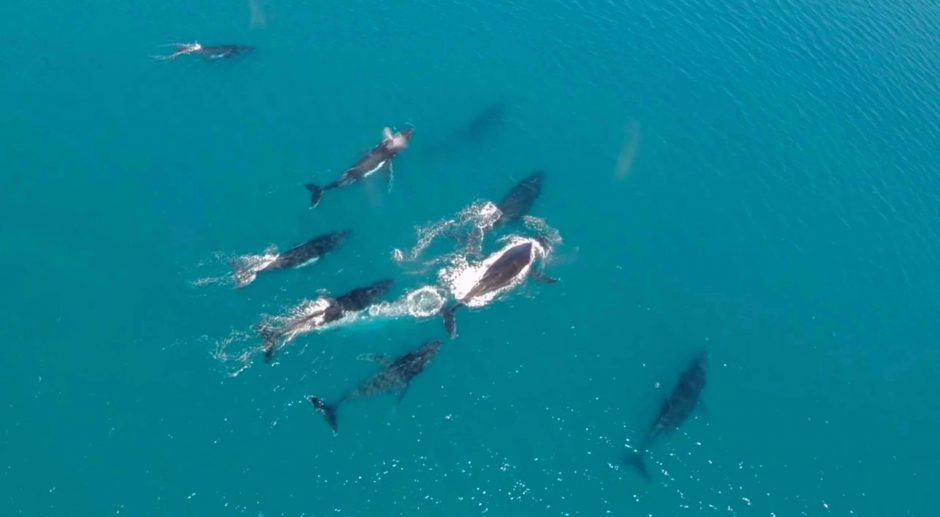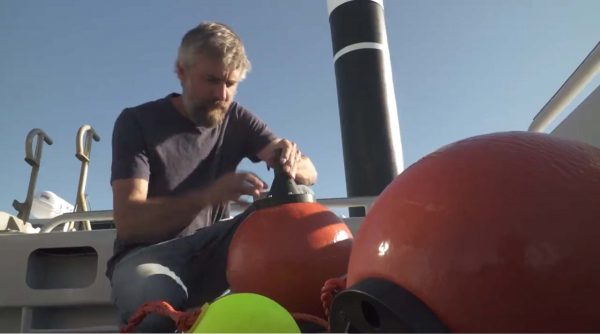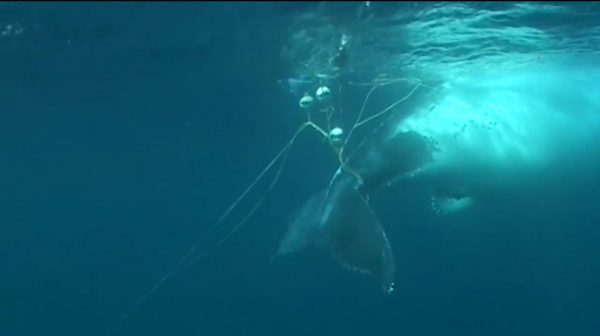New Hope for Entangled Whales From Tracking Buoys

Aerial view of migrating humpback whales. (Credit: From source, screenshot from video, https://www.dropbox.com/s/gezvinljnn8lcmt/Whale%20media%20pack_7-6-2018.mp4?dl=0.)
A team of marine wildlife experts and government scientists in Western Australia (WA) have developed a new real-time tracking tool for whale rescue.
“The buoys utilize a GPS to provide positional data, which is transmitted using an Iridium satellite modem,” explains Dr. Jason How, a Research Scientist on Invertebrates with the Sustainability and Biosecurity section of the Department of Primary Industries and Regional Development (DPIRD) in Western Australia.“This is controlled by a customized motherboard that utilizes data from a wet-switch and a control log to determine if and when a signal should be sent. Parameters associated with transmission can be altered remotely (while the whale is towing the buoy), such that battery life can be preserved through reducing transmission rate if a disentanglement operation is not imminent. Conversely, the transmission rate can be increased so that more positional data is provided when a disentanglement operation has been launched.”
The 10 trackable buoys are strategically placed with specialist whale disentanglement teams between Broome and Esperance, with three in Perth.
“This corresponds to the location of trained disentanglement teams along the Western Australian coast,” details Dr. How. “Approaching whales, and an entangled whale, in particular, is a dangerous operation that requires specific training and approvals. The Parks and Wildlife Service of the Department of Biodiversity, Conservation and Attractions (DBCA) has trained teams around the State to respond to entangled whales. Therefore, 10 buoys were produced to provide each team with a buoy while having a couple of buoys in ‘high risk’ areas should multiple operations occur simultaneously, or if a buoy at another location is deployed then a buoy can be moved to that location until it is retrieved.”
The technology enables responders to see the real-time locations of whales that have become entangled in fishing gear. This real-time data, in turn, permits remote monitoring before any disentanglement efforts.

New satellite buoy being prepared by researcher on boat. (Credit: From source, screenshot from video, https://www.dropbox.com/s/gezvinljnn8lcmt/Whale%20media%20pack_7-6-2018.mp4?dl=0.)
“Without real-time tracking, positional data would be stored by the buoy and could only be retrieved when the buoy is retrieved,” Dr. How describes. “Entangled whales are often not re-sighted after they are initially sighted and therefore getting the data back would not occur. Also, if you re-sight the whale then you are able to attempt a disentanglement operation. The advantage of real-time tracking is that we know where the whale is and an intercept of the whale can be planned when weather, daylight hours and assets (vessels and trained personnel) are available.”
Currently, approximately 35,000 whales migrate between calving areas in the Kimberley and Antarctic waters. The northernmost of nine sections of Western Australia, the Kimberley is bordered on the north by the Timor Sea, and on the west by the Indian Ocean.
“Entanglements in WA have historically occurred at a low level,” remarks Dr. How. “However, the humpback whale population off WA has recovered very well since commercial whaling stopped, with an estimated population growth of over 10% per annum and tens of thousands of humpback whales migrating along the coast each season. With such a large population now moving past the WA coast, along with a change in the management of the State’s rock lobster fisheries permitting year-round fishing, there was a greater interaction between fishing gear and migrating humpback whales.”
In fact, in 2013, 17 entanglements in western rock lobster gear occurred, a peak that prompted the introduction of a range of gear modifications.
“These gear modifications have been successful in reducing entanglements, with only six entanglements recorded in commercial western rock lobster gear last year (2017),” adds Dr. How. “Industry and government are continually committed to mitigating impacts of fishing on whales off WA, and these whale buoys are part of that strategy.”
The buoys are not yet used for any other purpose, although Dr. How states that the technology could be adapted to provide positional data for a range of marine applications.
When an entangled whale is detected, the DBCA Parks and Wildlife Service is notified, and the wheels are in motion.

Underwater shot of humpback whale entangled in ropes and floats. (Credit: From source, screenshot from video, https://www.dropbox.com/s/gezvinljnn8lcmt/Whale%20media%20pack_7-6-2018.mp4?dl=0)
“At this point, they will determine if they are able to attach a buoy to the whale,” comments Dr. How. “This will be impacted by weather, daylight hours, crew/vessels and also if the reporter of the entanglement is able to stay with the whale until a crew arrives. Previously this process was what was required to attempt a disentanglement. Now with the tracking buoy, the impacts of weather, daylight hours and crew are vastly reduced as buoy attachment can occur in rougher weather, in less time and with a smaller crew than a disentanglement operation.”
Once a buoy is attached, first responders can plan so the disentanglement operation will occur under the most favorable conditions. This ensures greater safety for the disentanglement crew, not to mention a better chance of a positive outcome for the whale.
Although the system is new, it is based on a successful prototype that was deployed in 2017.
“An entangled whale was sighted late on an afternoon,” recounts Dr. How. “The Parks and Wildlife Service put a small team together and attached the buoy. The whale was tracked over 48 hours and intercepted on the third morning with a successful disentanglement operation. This was possible as a team could be assembled and be on site at first light to attempt the disentanglement. If the buoy wasn’t attached, it is unlikely that the whale would have been sighted again, and if it was weather, time and asset constraints, would potentially again been issues to deal with.”
Moving forward, researchers may be able to glean more information about these endangered whales, even as they work to prevent their entanglement.
“The deployment of the tracking buoy, along with other information from entangled whales, has indicated that when a whale is entangled it will typically not continue its migration, but rather may move in an opposite direction to the overall populations’ migration,” remarks Dr. How. “This has implications in re-locating entangled whales when a tracking buoy is not available to re-sight the whale. We are hoping that information from entangled whales tracked with this buoy will provide greater information on the movement patterns of entangled whales to assist in areas where this technology may not be available.”
Top image: Aerial view of migrating humpback whales. (Credit: From source, screenshot from video, https://www.dropbox.com/s/gezvinljnn8lcmt/Whale%20media%20pack_7-6-2018.mp4?dl=0)




0 comments